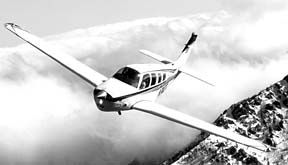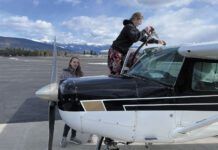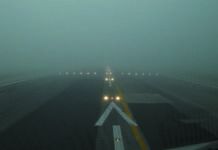
The concept of learning to fly instruments is more appealing than the reality. Earning an IFR rating is hard work and, ultimately, tedious.
But forget concepts. Lets talk money.
Everyone knows that having an instrument rating lowers your insurance premium. Well put some numbers on that in a moment but consider something else.
If you want to buy kinds of high-performance airplanes or high limits on something more modest, its getting to the point where some insurance companies wont even look at you unless your certificate is stamped: Instrument Airplane. So whats it cost to earn an instrument rating these days? It varies according to how much experience youve got and whether you train through the local FBO, take a quickie concentrated course or do something else. Bottom line, figure on about $4000, average.
Whats the payback? The bad news is there may be no direct payback, depending on your situation. Every insurer underwrites a bit differently and sometimes there will even be substantial variation between branch offices of the same company. We can apply few specifics across the entire spectrum of companies and there are exceptions to every rule.
First, the economic value of an instrument rating hinges on the kind of airplane you fly. If you fly a four-seat, single-engine fixed-gear airplane such as a Cherokee or a Skyhawk, getting your instrument rating may or may not save you money on insurance, depending on the company youre with.
If you fly a retractable four-seat single-a Mooney 201, Arrow or Cutlass-youll save a bit more but more important, youll be able to buy higher limits of liability and have more insurers to choose from. This matters a lot to owners who own businesses or otherwise have assets to protect from potential lawsuits.
If you operate a fire-breathing turbocharged single, especially a six seater, you probably wont be able to buy more than minimal limits unless you have the IFR ticket in your pocket. If you have a pressurized airplane, or a twin, you might find insurance but it will be expensive and the coverage limited.
And if youve gotten all the way into a turbine-powered airplane without learning the gentle art of blind flying, just fuggedaboutit, as they say in the big city. You might think no one gets that far without an instrument rating, but with all the money chasing new airplanes these days, youd be surprised.
Less Risk
The logic of insurance companies here is as simple as gravity: The bigger and faster an airplane is, the quicker it can get you into weather-related trouble and the more folks you can take with you. That goes double at night.
Another factor in the risk equation is your flight experience. In general, the less time you have, the bigger the savings will be if you get an instrument rating. This is because as a low-time VFR pilot, youll be paying a higher premium to begin with, unless you own something really cheap and really slow.
Its the old risk-and-reward equation: The more risk you save your insurance company for shouldering, the more theyll reward you with lower premiums. So the 200-hour Bonanza pilot who gets his IFR will see more savings than the 3000-hour Warrior pilot.
This all begs the question of IFR experience and proficiency. Most general aviation pilots log between 50 and 75 hours per year, some less. Its a safe bet that a good percentage of instrument-rated pilots are not proficient at any given time. In other words, in the insurance companys eyes, if old Ernest got his IFR ticket stamped just after the Big One and you got yours last week at Flight Safety, the insurance company wont notice. All they care about is that you have the IFR in the first place.
So why do insurers care? Believe it or not, theres a sensible rationale for this. In the first place, most underwriters believe that instrument-rated pilots have learned to divide their attention between flying the airplane and maintaining situational awareness, tuning radios and the dozens of other cockpit chores you learn to manage under IFR. Ergo, the IFR pilot is deemed more likely to get from A to B safely.
While approach skills get rusty quickly if unused, the ability to fly the airplane with only part of the brain will probably remain long after the checkride. And even a well-oxidized instrument pilot can probably keep the airplane upright long enough to get turned around if he gets into weather.
The other reason proficiency isnt a big deal is simply the difficulty of keeping track of six-month IFR currency. Insurance companies shuffle enough paper and thus take a bye on the chore of tracking currency.
Except sometimes they dont. If you have an instrument rating and fly a complex airplane, many companies will ask about training received during the past year at each renewal, especially if you carry high liability limits. USAIG has for years stressed the benefits of recurrent training in all types of airplanes and if you have an instrument rating, their underwriter will probably require a proficiency check annually, at the very least. Most other insurers require annual training of some sort in pressurized singles and cabin-class twins.
Phoenix Aviation also told us that in certain airplanes, they make a six-month IPC part of their requirements. USAIG, Phoenix and other companies have additional coverages which they provide free of charge to preferred pilots. Thats code for an accident-free pilot with a current instrument rating.
Another factor cited by several underwriters was geography. Two told us that they looked more favorably upon instrument-rated pilots in high density traffic areas such as the northeast corridor, Chicago and Los Angeles.
Another said that he worried less about VFR pilots in areas such as Florida or Arizona than in the Midwest and Northeast, another way of saying that he would reward IFR pilots less in the former area and more in the latter.
Another factor in determining how much youll save by getting your IFR rating is how much insurance you buy in the first place. The greater the limit of liability you carry, the more youll save. In some cases, in order to buy higher limits-especially smooth coverage-the rating will be a no-discussion requirement. Smooth or level coverage has a single limit, without per passenger or per person maximums.
The insured value of your airplane can also be a factor. One underwriter told us that his program guidelines didnt allow him to quote airplanes with hull values over $90,000 unless the pilot had an instrument rating. These days, thats not unusual, although its not quite universal. Yet. And $90,000 doesnt buy much of a serious traveling airplane these days.
To get an idea of the type of savings and other benefits that insurers shower upon instrument-rated pilots-laureate, we approached several companies and posed identical pilots, one instrument rated, one not.
Ultimately, our attempt to scientifically measure this failed because every company seemed to have different requirements, rating guidelines, favorite and least-favorite airplanes and a host of other variables.
In general, there were three schools of thought among insurers when distinguishing between IFR and VFR pilots. The first group applied a flat credit percentage for instrument pilots, without regard to the type of airplane, as long as it was an airplane that theyd insure for VFR pilots. AVEMCO told us they gave their instrument-rated policyholders a 10 percent credit across the board. Another underwriter, who asked that we not use his companys name, told us that they gave the same credit for IFR pilots in J-3s as in a Mooney 201.
This seemed typical of several of the companies that rely heavily on computer algorithms for rating. These included AIGs Light Aircraft Division, Great Americans Express program and AVEMCO.
The second group gave little credit for the instrument rating in airplanes where they didnt require it as a prerequisite.
The third group underwrites each situation individually, considering in addition to IFR status, the aircraft type, geographical location, the pilots total time, class time (RG, tail wheel, etc.), make and model time, time in the last year, training, and claims history.
This is the approach of companies that use experienced underwriters (humans) for rating, such as USAIG, Phoenix and HCC Aviation. Several computerized underwriters also varied the amount of credit for the IFR and cited most of the same factors as the others.
Most companies also told us they dont apply credit for the rating until the next renewal. This seemed to be true of all of the companies except AVEMCO. Most would, however, provide higher liability coverage mid-year to new IFR recipients if they qualified for it.
Hard Numbers
Heres what we found, in general terms, broken down by aircraft type:
The first category we asked about was the four-seat fixed-gear airplane. We were immediately stymied by definitions. At least one company differentiated between light singles and heavy singles. Cessna Turbo Skylanes for instance, were considered heavy by this company and were looked at differently than Cessna Skyhawks. In general, pilots with 300 hours total time saved between 5 and 15 percent of their total annual premiums by adding instrument ratings.
This amount varied considerably from one underwriter to another and was also influenced by the pilots experience in the same make and model of airplane. As a pilots total time increased, the amount of savings decreased, to the extent that several companies did not differentiate between IFR and VFR pilots with more than 1000 total hours.
There were no companies in this group who would not offer coverage to low-time VFR pilots, but a number would only quote liability coverage sub-limits of $100,000 per passenger and would not offer smooth coverage.
We then looked at lower horsepower retractables, the Cardinal RG, Sierra, Mooney 201 and Arrow. We found at least one carrier that would not insure pilots stepping into their first retractable at all. Such is the market that they can afford to be choosy.
Several others wouldnt offer quotes to VFR pilots making the transition into a retractable airplane, so we postulated a pilot with 300 total hours and 50 hours in retractables. About two thirds of the companies offered quotes with per passenger sub limits. Only two offered smooth coverage.
$1 million was highest liability limit we could find for VFR-only pilots. IFR pilots made out better, with six companies quoting in all, and three offering smooth coverage.
The IFR/VFR price difference for sub-limited coverage tended to be in the area of 10 percent, but varied from nothing to around 15 percent. Level limit coverage had a delta between IFR and VFR of as high as 30 percent.
We then asked about higher time VFR pilots, presenting a pilot with 1000 total hours and 200 in retractables. This time, four underwriters offered smooth coverage and premiums were almost the same as for the original 300-hour IFR pilots.
In the six-place fixed-gear category, we found a mixed response. The majority of underwriters felt that these airplanes were meant to go places and carry people, and should be flown by IFR pilots.
A smaller segment of the market told us that these were, after all, relatively simple, slow-moving airplanes and didnt pose speed or workload challenges as great as many of the faster four-seat singles.
Most underwriters told us that they required an instrument rating for turbocharged airplanes, because these operate up high, increasing the possibility of getting on top of weather.
In the big-bore and turbocharged single engine retractable class including Bonanzas, Mooneys Ovation, 252 and TLS, and the Cessna 210, we postulated a pilot with 500 hours and 50 hours of retractable experience.
The amount of the premium difference was about the same as the previous category, but there were very few options for VFR pilots and smooth limits were essentially not available without an instrument rating. Pressurized airplanes are just about uninsurable for VFR pilots. If you can find coverage, it will be expensive and smooth limits will probably not be available. For twin and turbine owners, the IFR was simply a must-have. End of story.
Worth It? Yes
Precisely how much you save will depend upon a large number of variables, but theres no doubt about the verdict: Insurance companies like their clients to have instrument ratings.
The numbers that we came up with should be treated as blue sky estimates rather than numbers to plug into a spreadsheet. If youre looking for an accurate number for planning purposes, we recommend that you call your insurance provider for an actual quote.
In general, instrument-rated pilots saved money in every category of airplane that we looked at. They saved greater percentage amounts in more complex airplanes and also had a greater variety of insurers to choose from than their VFR brethren.
Additionally-and this is probably the most important economic aspect of an instrument rating- they also were able to buy higher limits of coverage, get additional coverages and be insured in more expensive airplanes.
The rating seemed to have the greatest benefit for low-time pilots in complex and six-place airplanes, in some cases reducing their premium by as much as 30 percent.
So, if you want the insurance company to help you pay for your instrument training bills, buy a Bonanza, Centurion, Ovation or Saratoga. Anything less and they wont save you much. Anything more and they wont sell you insurance at all.
Also With This Article
Click here to view the Insurance Checklist
-by Jon Doolittle
Jon Doolittle owns and operates Sutton James Insurance in Hartford, Connecticut. Hes an Aviation Consumer contributing editor.





